Fabrication of Composite Unidirectional Cellular Metals by Using Explosive Compaction
Abstract
1. Introduction
2. Experimental Investigation
2.1. Sample Preparation
2.2. Fabrication Method
3. Results and Discussion—Sample A
4. Results and Discussion—Sample B
5. Conclusions
Author Contributions
Funding
Conflicts of Interest
References
- Banhart, J. Manufacture, characterization and application of cellular metals and metal foams. Prog. Mater. Sci. 2001, 46, 559–632. [Google Scholar] [CrossRef]
- Meyers, M.A.; Lin, A.Y.M.; Seki, Y.; Chen, P.Y.; Kad, B.; Bodde, S. Structural biological composites: An overview. J. Min. Met. Mat. Soc. 2006, 7, 35–41. [Google Scholar] [CrossRef]
- Ashby, M.F.; Evans, A.; Fleck, N.A.; Gibson, L.J.; Hutchinson, J.W.; Wadley, H.N.G.; Gibson, L.J. Metal Foams: A Design Guide; Elsevier Science: Amsterdam, Netherlands, 2000. [Google Scholar]
- Fiedler, T.; White, N.; Dahari, M.; Hooman, K. On the electrical and thermal contact resistance of metal foam. Int. J. Heat Mass Transf. 2014, 72, 565–571. [Google Scholar] [CrossRef]
- Lefebvre, L.P.; Banhart, J.; Dunand, D.C. Porous metals and metallic foams: Current status and recent developments. Adv. Eng. Mater. 2008, 10, 775–787. [Google Scholar] [CrossRef]
- Fiedler, T.I.; Belova, V.I.; Murch, G.E. On the thermal properties of expanded perlite–Metallic syntactic foam. Int. J. Heat Mass Transf. 2015, 90, 1009–1014. [Google Scholar] [CrossRef]
- Sato, Y.; Yuki, K.; Abe, Y.; Kibushi, R.; Unno, N.; Hokamoto, K.; Tanaka, S.; Tomimura, T. Heat transfer characteristics of a gas flow in uni-directional porous copper pipes. Int. Heat Trans. Conf. 2018, 16, 8189–8193. [Google Scholar]
- Hokamoto, K.; Vesenjak, M.; Ren, Z. Fabrication of cylindrical uni-directional porous metal with explosive compaction. Mater. Lett. 2014, 137, 323–327. [Google Scholar] [CrossRef]
- Vesenjak, M.; Hokamoto, K.; Sakamoto, M.; Nishi, T.; Krstulović-Opara, L.; Ren, Z. Mechanical and microstructural analysis of unidirectional porous (UniPore) copper. Mater. Des. 2016, 90, 867–880. [Google Scholar] [CrossRef]
- Vesenjak, M.; Hokamoto, K.; Matsumoto, S.; Marumo, Y.; Ren, Z. Uni-directional porous metal fabricated by rolling of copper sheet and explosive compaction. Mater. Lett. 2016, 170, 39–43. [Google Scholar] [CrossRef]
- Hokamoto, K.; Shimomiya, K.; Nishi, M.; Krstulovic-Opara, L.; Vesenjak, M.; Ren, Z. Fabrication of unidirectional porous-structured aluminum through explosive compaction using cylindrical geometry. J. Mater. Process. Tech. 2018, 251, 262–266. [Google Scholar] [CrossRef]
- Crossland, B. Explosive Welding of Metals and Its Application; Clarendon Press: Oxford, UK, 1982; pp. 84–129. [Google Scholar]
- Mori, A.; Nishi, M.; Hokamoto, K. Underwater shock wave weldability window for Sn-Cu plates. J. Mater. Process. Tech. 2019, 267, 262–266. [Google Scholar]
- Parchuri, P.; Kotegawa, S.; Yamamoto, H.; Ito, K.; Mori, A.; Hokamoto, K. Benefits of intermediate-layer formation at the interface of Nb/Cu and Ta/Cu explosive clads. Mater. Des. 2019, 166, 107610. [Google Scholar] [CrossRef]
- Saravanan, S.; Raghukandan, K.; Hokamoto, K. Improved microstructure and mechanical properties of dissimilar explosive cladding by means of interlayer technique. Arch. Civ. Mech. Eng. 2016, 16, 563–568. [Google Scholar] [CrossRef]
- Bataev, I.A.; Hokamoto, K.; Keno, H.; Bataev, A.A.; Balagansky, I.A.; Vinogradov, A.V. Metallic glass formation at the interface of explosively welded Nb and stainless steel. Met. Mater. Int. 2015, 21, 713–718. [Google Scholar] [CrossRef]
- Nakajima, H. Fabrication, properties and application of porous metals with directional pores. Prog. Mater. Sci. 2007, 52, 1091–1173. [Google Scholar] [CrossRef]
- Hyun, S.K.; Ikeda, T.; Nakajima, H. Fabrication of lotus-type porous iron and its mechanical properties. Sci. Technol. Adv. Mat. 2004, 5, 201–205. [Google Scholar] [CrossRef]
- Sun, G.; Wang, Z.; Yu, H.; Gong, Z.; Li, Q. Experimental and numerical investigation into the crashworthiness of metal foam-composite hybrid structures. Compos. Struct. 2019, 209, 535–547. [Google Scholar] [CrossRef]
- Heat exchangers. Available online: http://www.gunji.co.jp/products/heat_exchanger.html (accessed on 18 October 2019). (In Japanese).
- Jung, A.; Pullen, A.D.; Proud, W.G. Strain-rate effects in Ni/Al composite metal foams from quasi-static to low-velocity impact behavior. Compos. Part A 2016, 85, 1–11. [Google Scholar] [CrossRef]
- Itoh, S.; Kira, A.; Nagano, S.; Fujita, M. Optical study of underwater explosion of high explosive. Kayaku Gakkaishi (Sci. Tech. Energetic Mater.) 1995, 56, 188–194. (In Japanese) [Google Scholar]
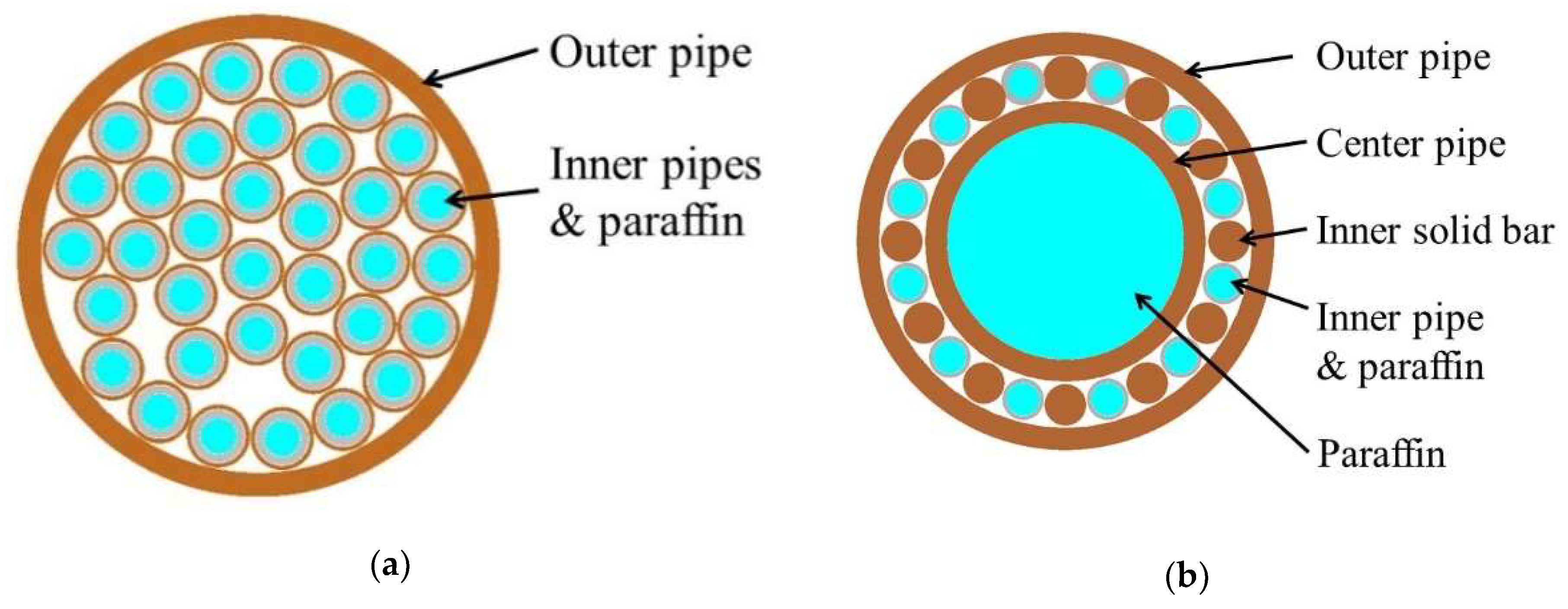
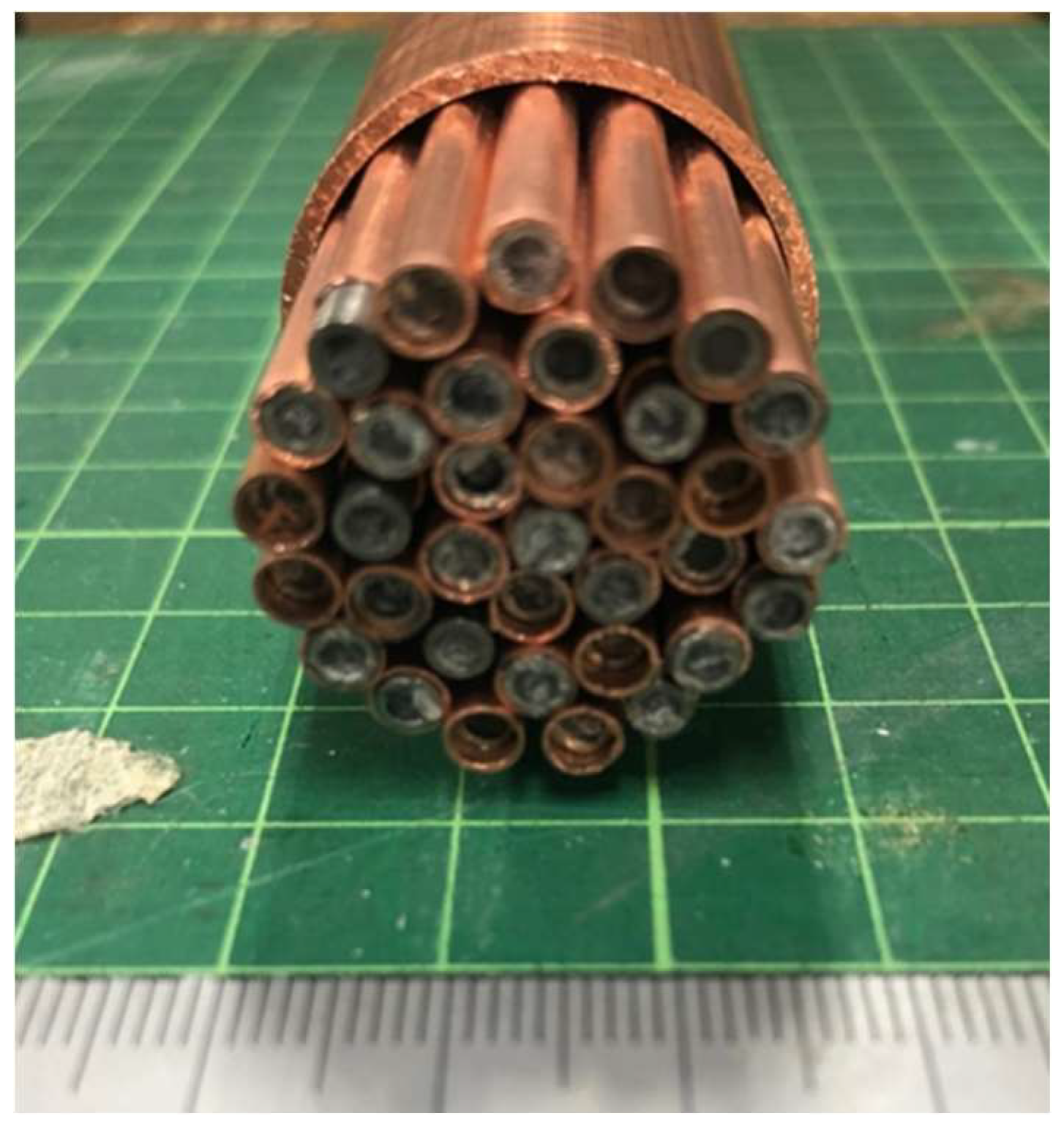
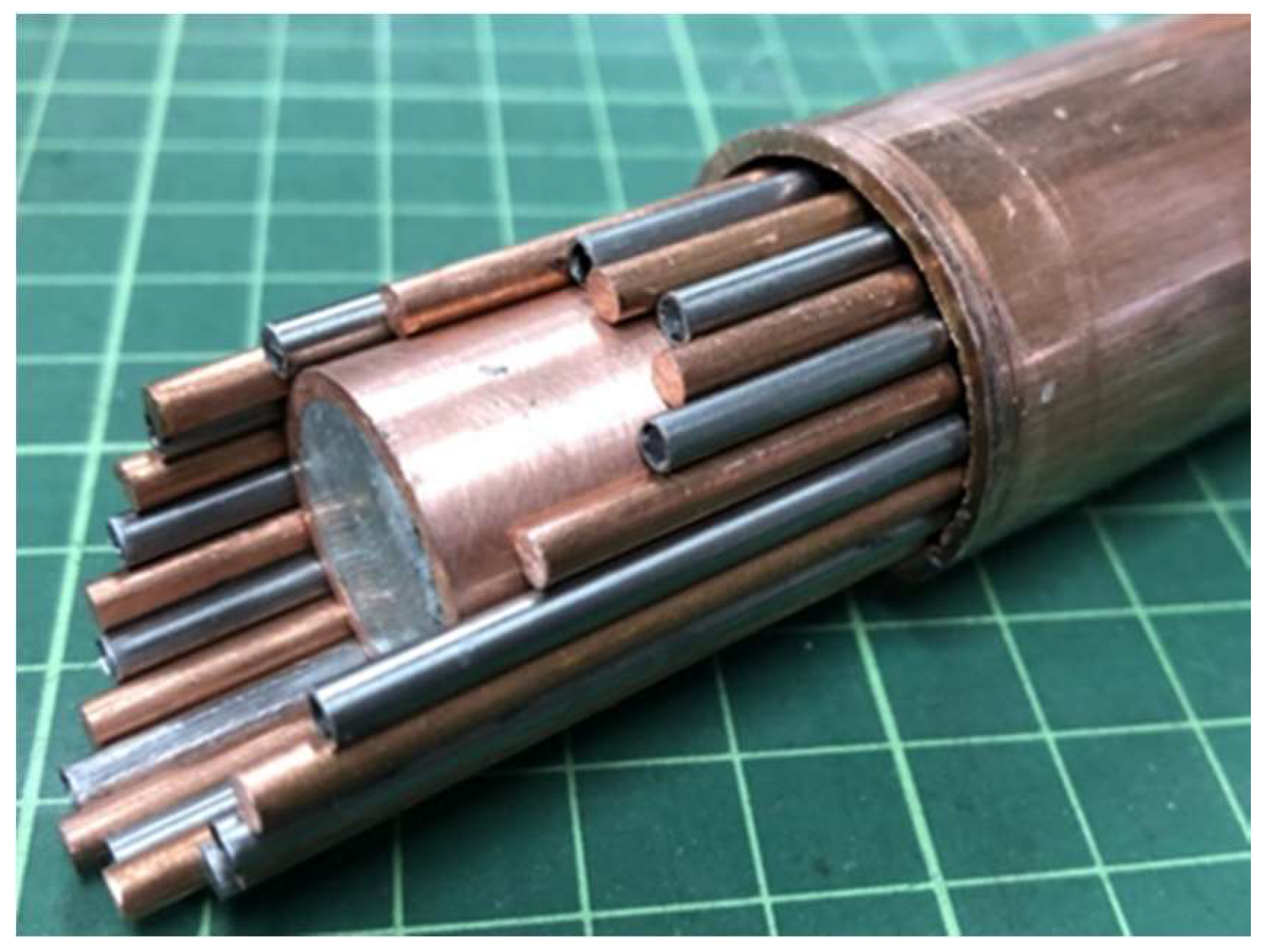
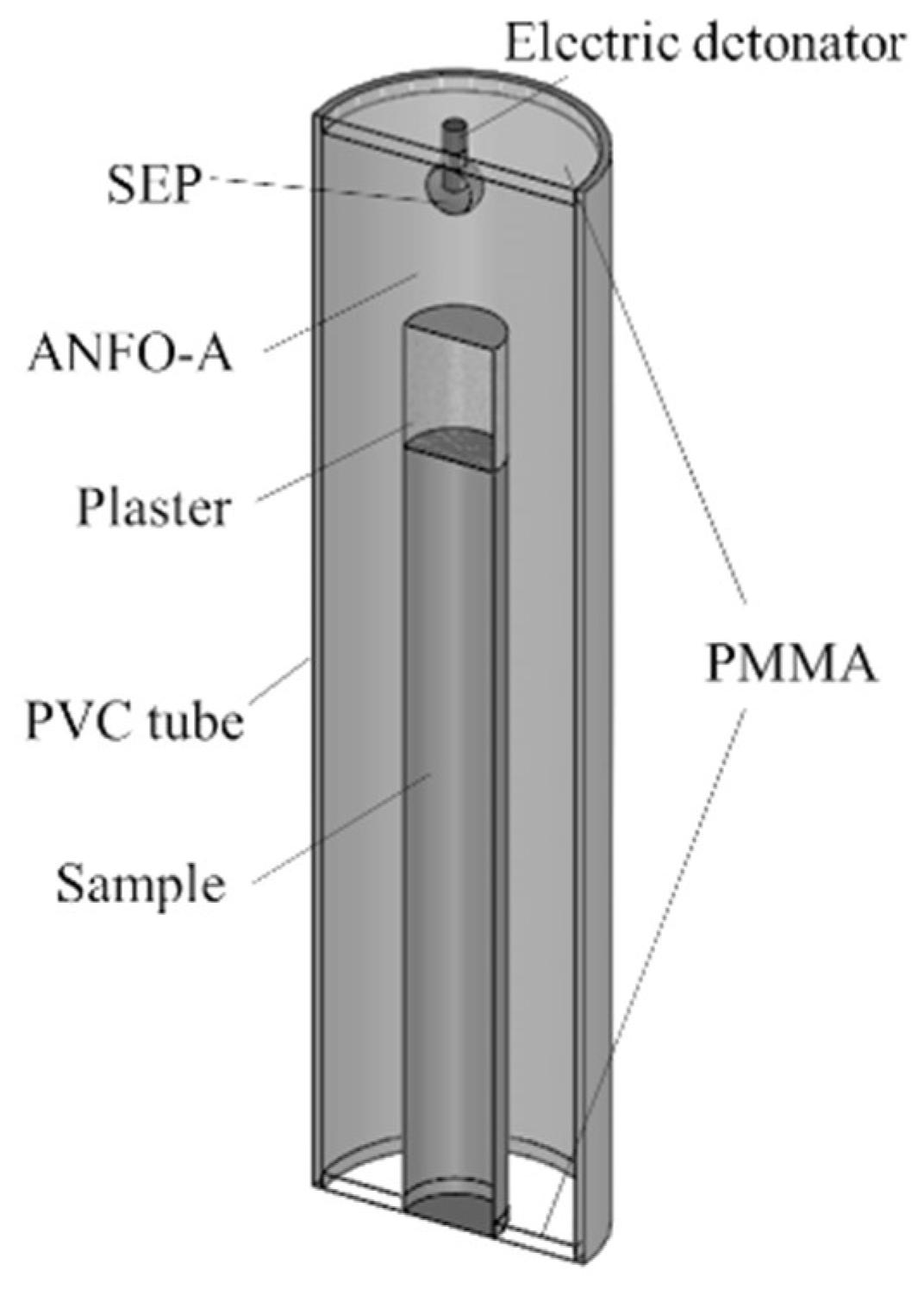
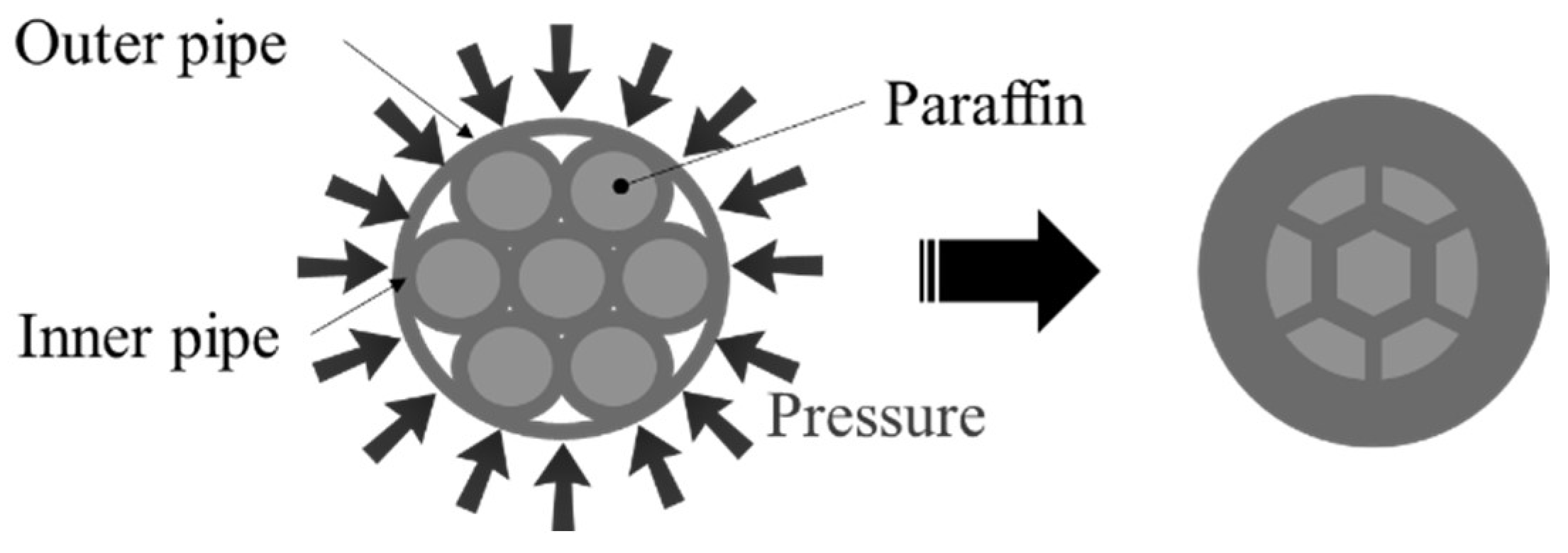

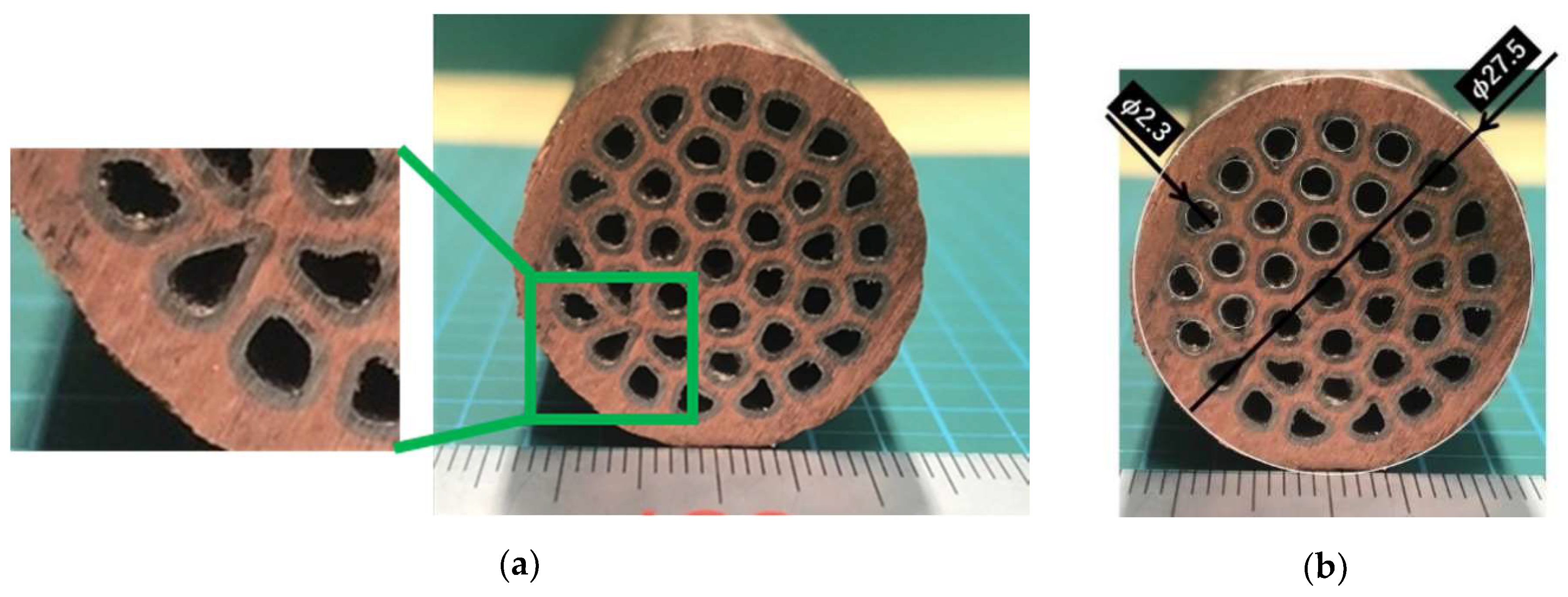
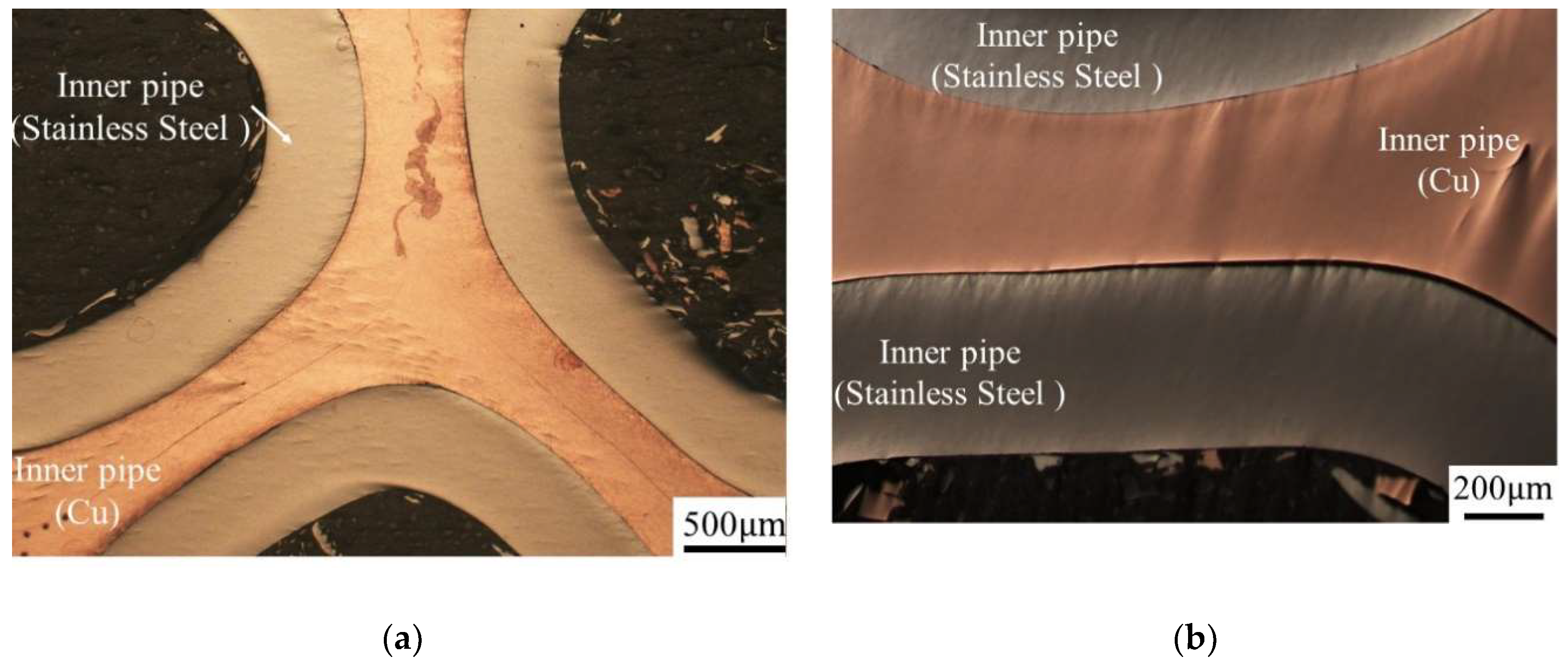

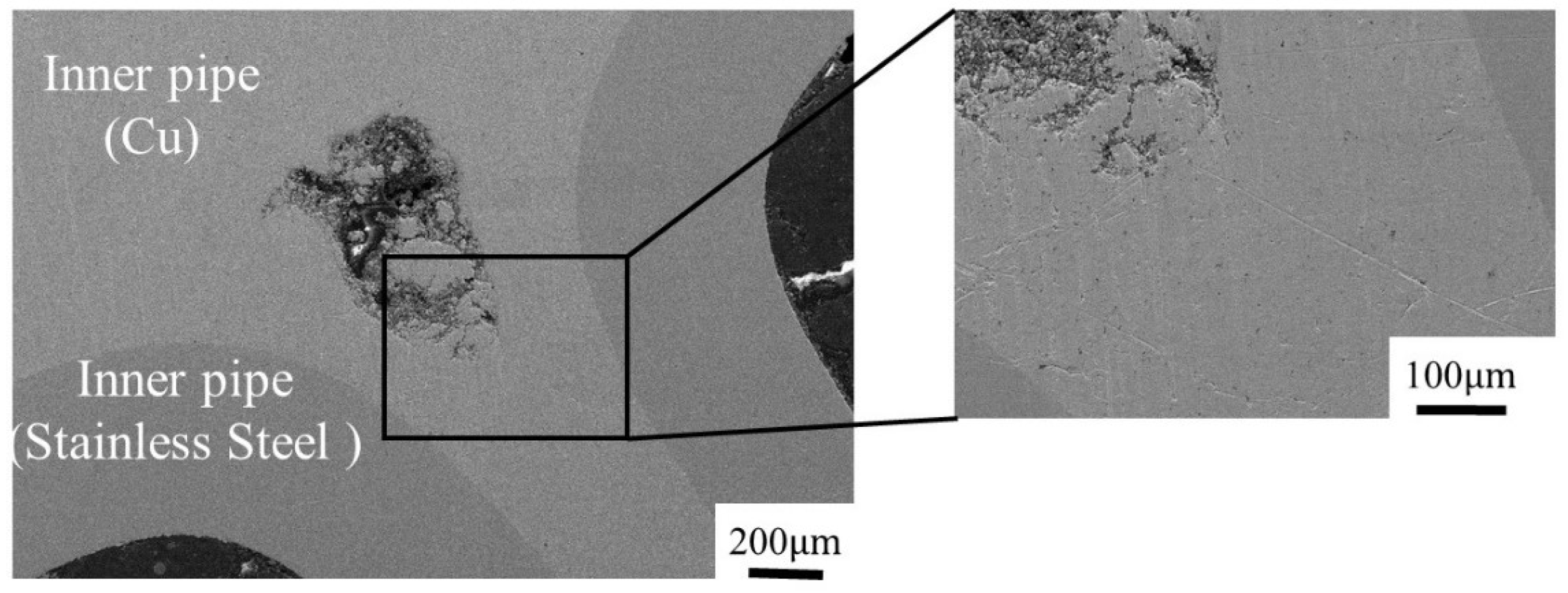

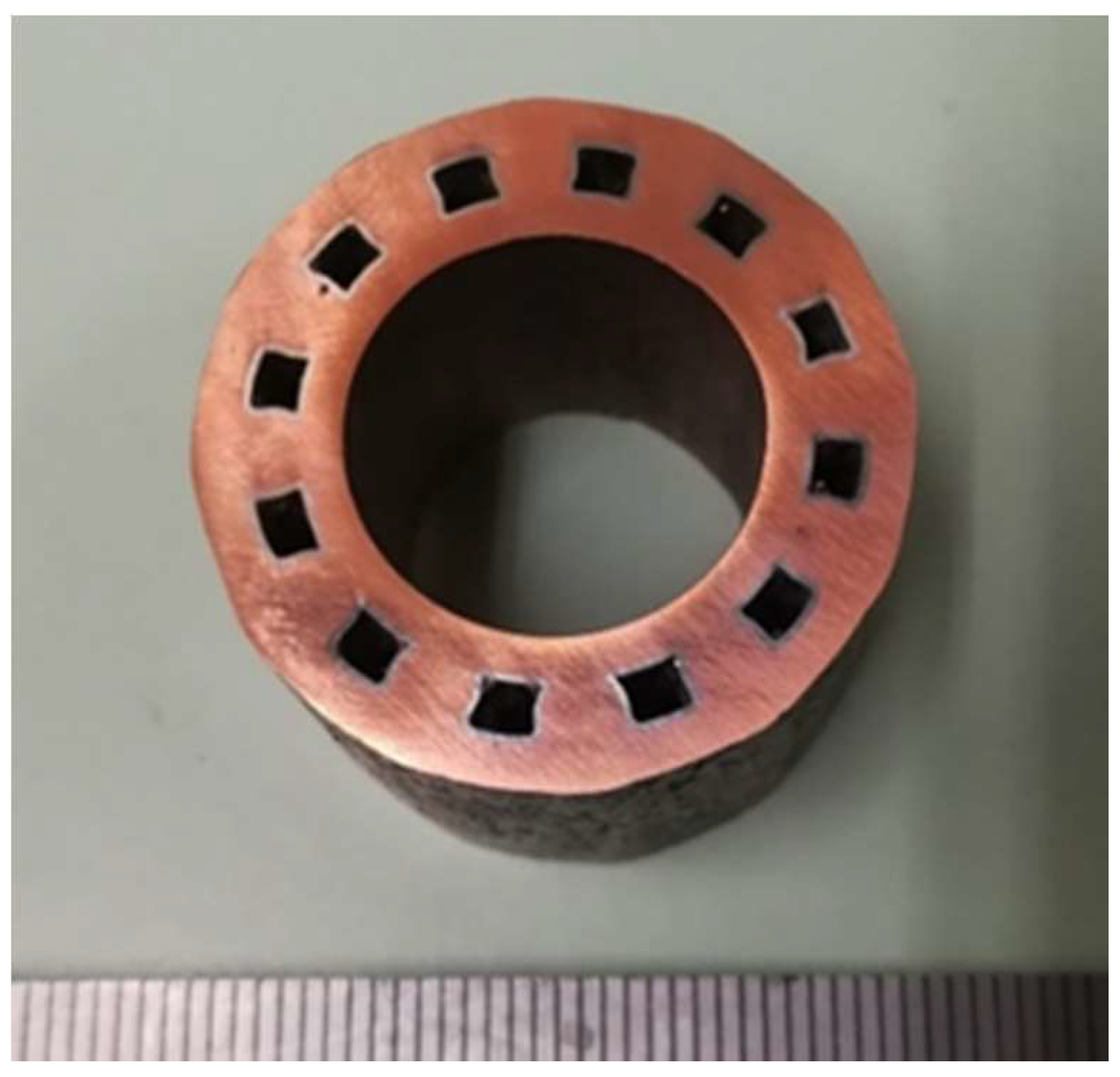

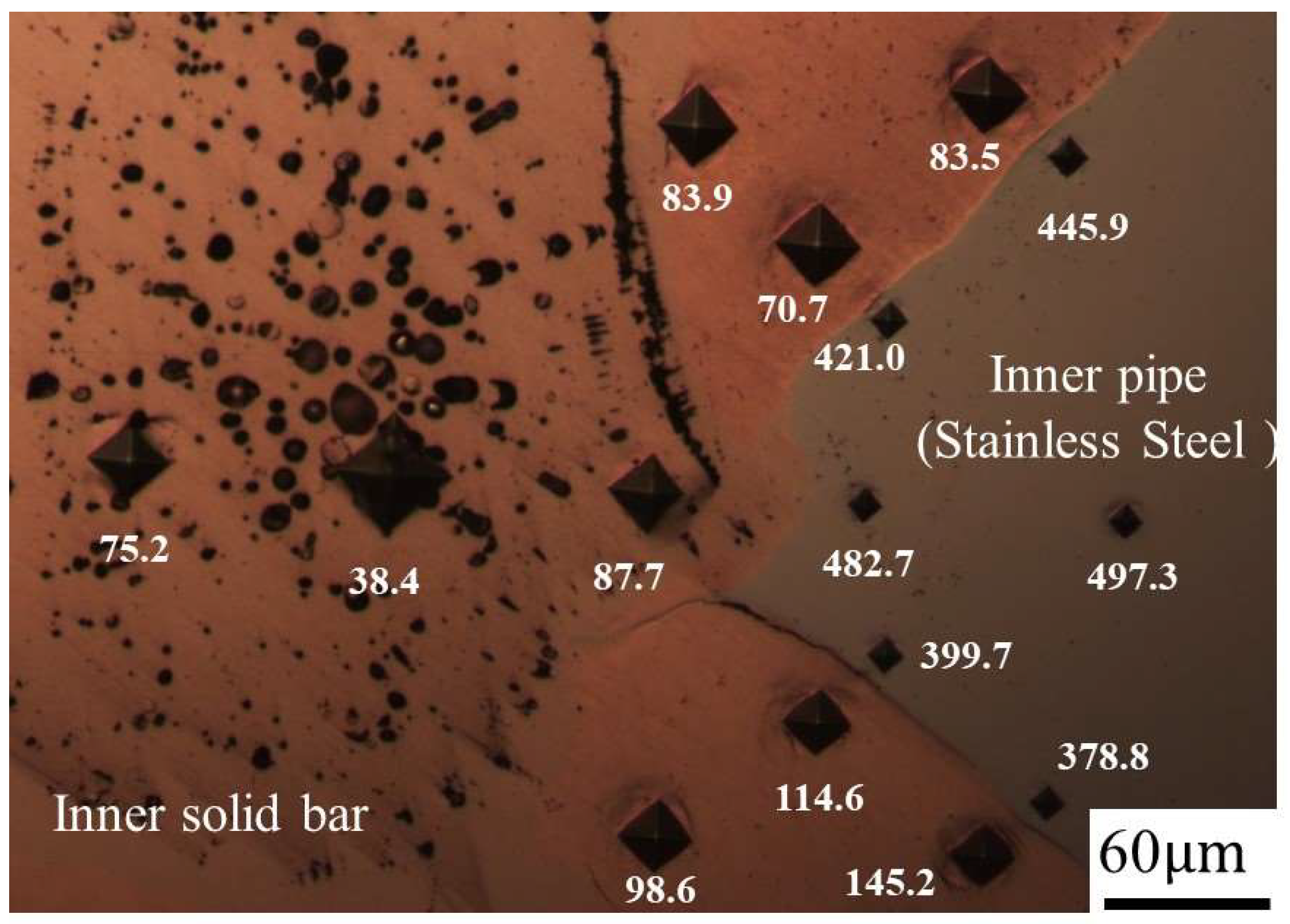
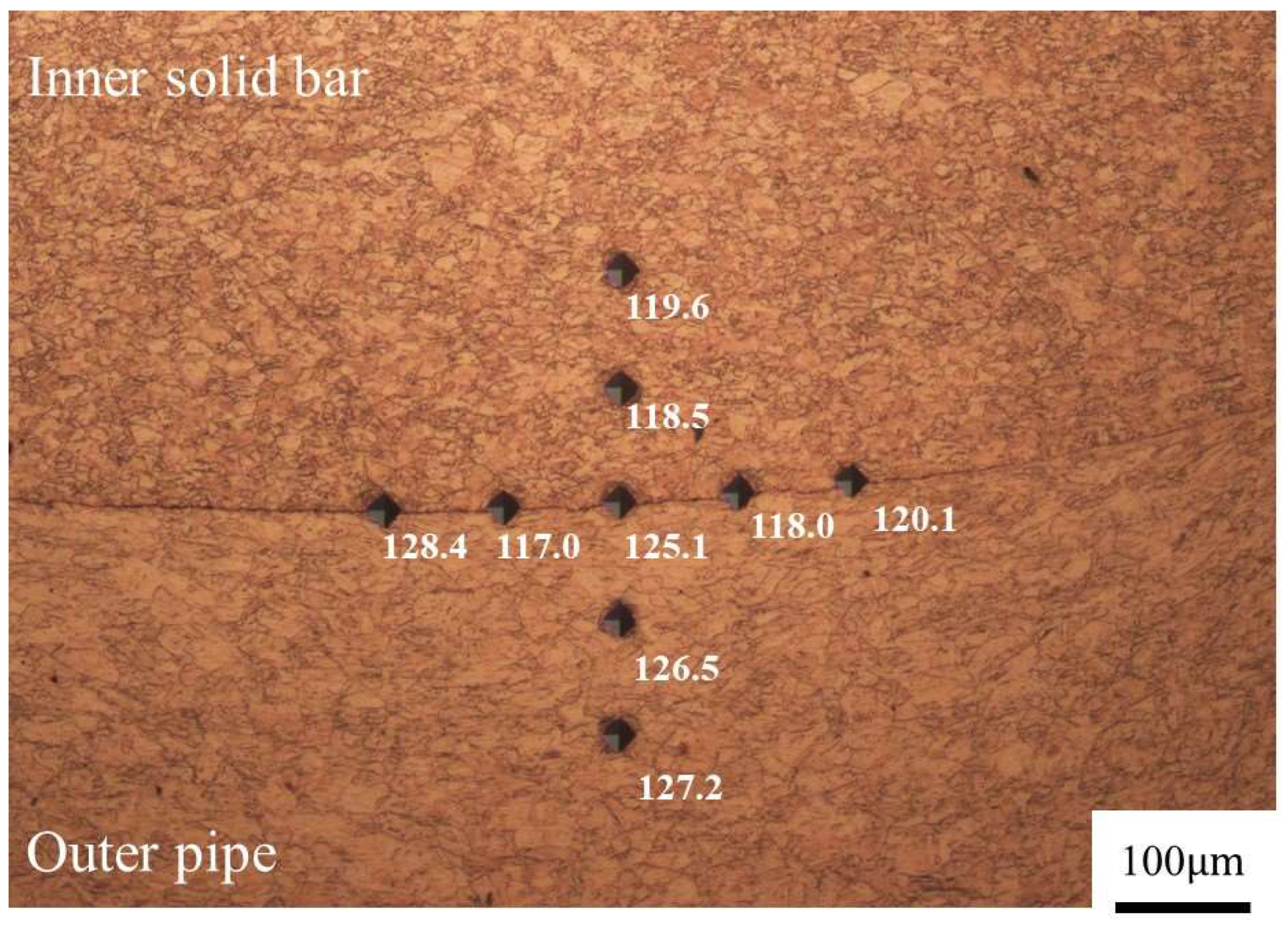
| Component | Material | Outer Diameter (mm) | Inner Diameter (mm) | Number | Length (mm) |
|---|---|---|---|---|---|
| Outer pipe | Cu (JIS-C1220) | 30 | 27 | 1 | 210 |
| Inner pipe | Cu (JIS-C1220) | 4.0 | 3.4 | 35 | 260 |
| Inner pipe | Stainless Steel 304 | 3.3 | 2.3 | 35 | 260 |
| Component | Material | Outer Diameter (mm) | Inner Diameter (mm) | Number | Length (mm) |
|---|---|---|---|---|---|
| Outer pipe | Cu (JIS-C1220) | 30 | 27 | 1 | 210 |
| Center pipe | Cu (JIS-C1220) | 20 | 17 | 1 | 200 |
| Inner solid bar | Cu (JIS-C1220) | 3.0 | - | 12 | 200 |
| Inner pipe | Stainless Steel 304 | 3.0 | 2.4 | 12 | 200 |
| Material | Density (kg/m3) | Ultimate Tensile Strength (MPa, Lower Limit) (Source: JIS) | Elongation at Break (Lower Limit) (Source: JIS) |
|---|---|---|---|
| JIS-C1220 | 8940 | 315 | - |
| Stainless Steel 304 | 8000 | 520 | 35 |
| Paraffin | 918 | - | - |
© 2020 by the authors. Licensee MDPI, Basel, Switzerland. This article is an open access article distributed under the terms and conditions of the Creative Commons Attribution (CC BY) license (http://creativecommons.org/licenses/by/4.0/).
Share and Cite
Nishi, M.; Tanaka, S.; Vesenjak, M.; Ren, Z.; Hokamoto, K. Fabrication of Composite Unidirectional Cellular Metals by Using Explosive Compaction. Metals 2020, 10, 193. https://doi.org/10.3390/met10020193
Nishi M, Tanaka S, Vesenjak M, Ren Z, Hokamoto K. Fabrication of Composite Unidirectional Cellular Metals by Using Explosive Compaction. Metals. 2020; 10(2):193. https://doi.org/10.3390/met10020193
Chicago/Turabian StyleNishi, Masatoshi, Shigeru Tanaka, Matej Vesenjak, Zoran Ren, and Kazuyuki Hokamoto. 2020. "Fabrication of Composite Unidirectional Cellular Metals by Using Explosive Compaction" Metals 10, no. 2: 193. https://doi.org/10.3390/met10020193
APA StyleNishi, M., Tanaka, S., Vesenjak, M., Ren, Z., & Hokamoto, K. (2020). Fabrication of Composite Unidirectional Cellular Metals by Using Explosive Compaction. Metals, 10(2), 193. https://doi.org/10.3390/met10020193







